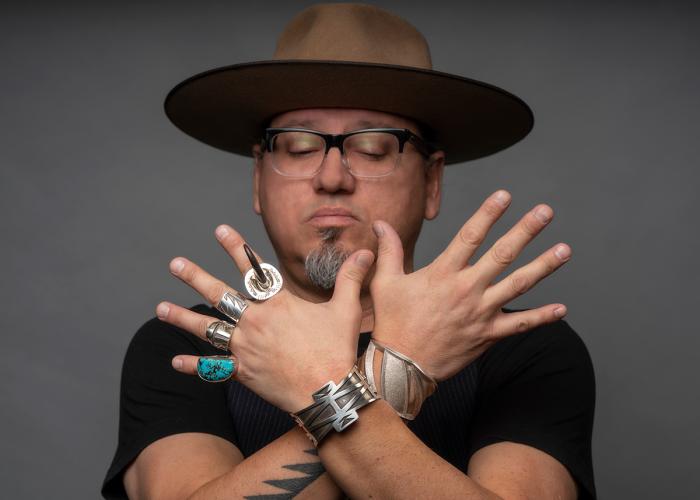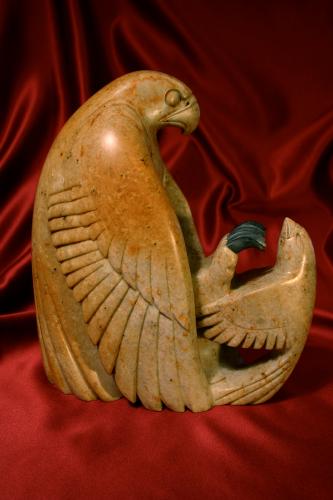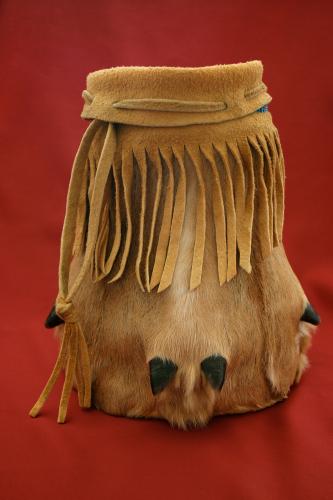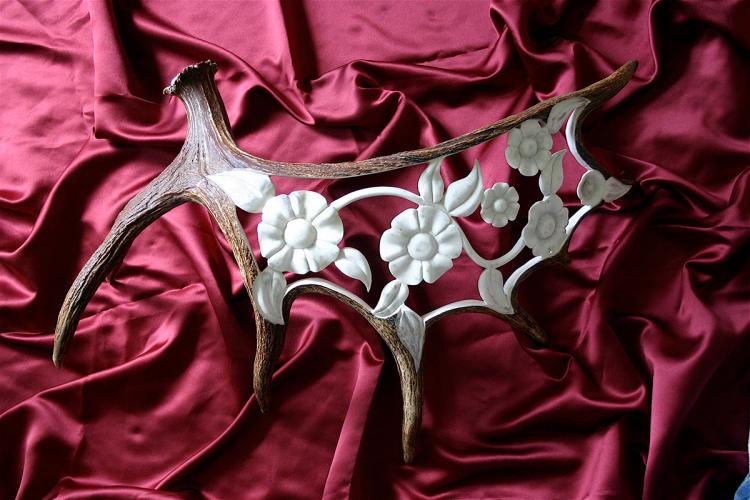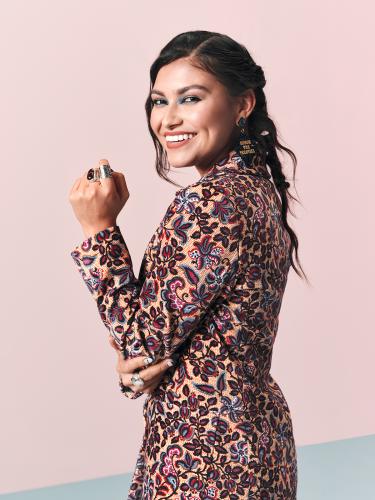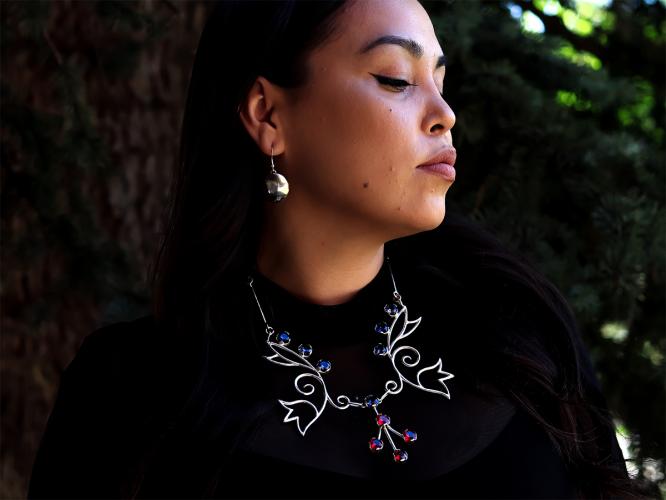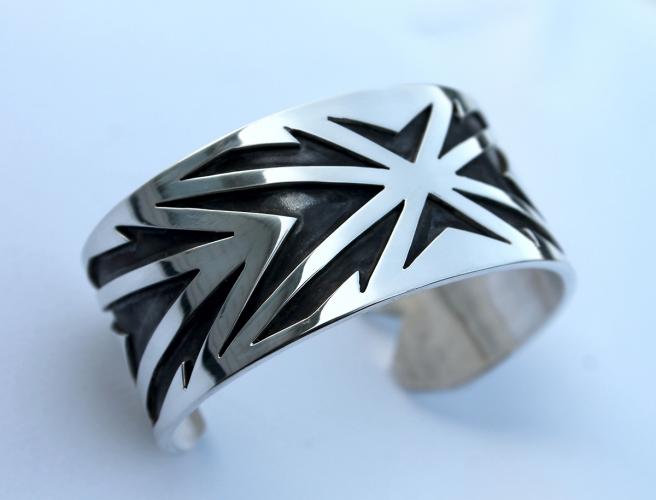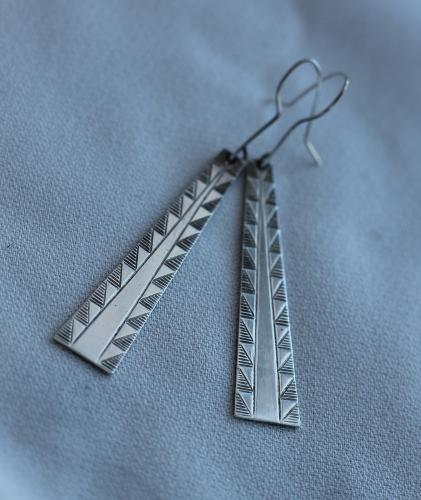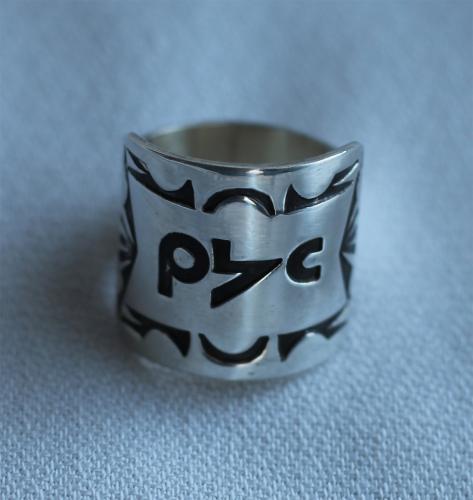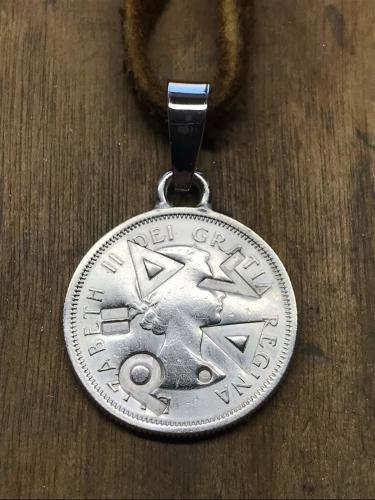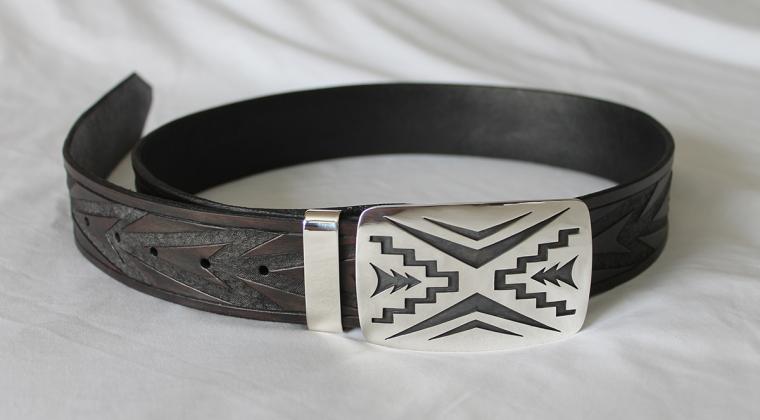In spite of being a relatively new arrival to the art scene, Erik Lee has already carved out a niche. His silver pieces are distinct in that their contemporary, graphic looks are inspired by designs from his Plains Cree culture. The result is that in just more than a decade of creating works in metal, Lee’s striking jewelry has already gained recognition in Canada and the United States and recently has been worn by a star strolling on a red carpet.
The artist has had a banner year in 2022. This past August, a belt he created won first place in the “buckle” category at the Santa Fe Indian Market. Then the National Museum of the American Indian selected him to be among the artists at its annual Native Art Market in December. This event showcases works by dozens of Indigenous artists from across the Western Hemisphere.
Learning by Watching
Lee is from the Maskwacîs Reserve in Alberta, Canada, a community of four First Nations, including the Louis Bull Tribe as well as the Ermineskin, Montana and Samson Cree Nations. The Cree are the largest group of First Nations in Canada, with more than 350,000 people across eight geographical and linguistically distinguished regions. The Plains Cree have homelands in Alberta, Manitoba, Saskatchewan and Montana.
Lee credits his family and culture with inspiring him. “I was influenced at a really early age by a lot of the artists in my family—my mother, my grandmother—and then just growing up around the culture and seeing the vibrant floral and geometric designs.” Lee said he was “awestruck” by his mother’s beautiful beadwork. She would create decorative pieces for regalia, such as belts, belt buckles, barrettes and other hair ornaments. He was even given modeling clay with which to experiment. But in the beginning, he didn’t see this as his career. “As a young person, I used art as a form of entertainment and play.”
As an adult he discovered the structure of an office job wasn’t for him. “I’ve done that whole thing of wearing a suit and tie,” he said. He found art in different forms allowed him to discover himself and follow his own path. “This is where I’m most comfortable and most fulfilled.”
Lee first adopted the Cree floral and geographic designs and artisan forms his family and ancestors embraced, not only creating beaded belt buckles and bracelets but also tanning hides, fashioning tools and carving sculptures from animal antlers, wood and stone. “When carving was my main focus, I would carve things that I saw, animals, birds, etc…I would try and have the subject rendered as realistically as possible and with as much movement and emotion as the medium allowed. I would also recreate historical items like tools and utility items with as much authenticity as possible regarding traditional materials and techniques,” Lee recalled. “It takes a lot of research and attention to detail. Some things I was lucky enough to have inherited—the skill and knowledge to process and use traditional materials and the genetic Indigenous curiosity and inspiration to want to.”
Although he enjoyed working in these materials and traditional forms, Lee says he knew his growth as an artist would have to evolve to reflect his personal style. After moving to British Columbia in 2007, Lee sought to connect with Native artists in the area. There, Lee met Jackson Robertson, a master wood and metal carver from the Kwakwa̱ka̱ʼwakw community of the Kingcome Inlet on Canada’s west coast. When Lee first started observing Robertson, “He said, ‘I can’t teach you. You can just sit there and watch me. Then you try,’” he recalled. “Jackson’s art is very freeform. He has deep roots in his nation’s design traditions, but he also creates work that is abstract, intricate and playful, often incorporating many intertwined characters and figures in one unified composition. The guy has an imagination like you wouldn’t believe.”
Although he would return to his former homelands just two years later, the experience was transformative. Lee started working with metals, and although “It was just kind of a progression that I didn’t really plan,” said Lee, something clicked for him. “It just felt really, really natural.”
Robertson said that he quickly noticed the respect Lee had as an artist. “He started doing his plan and style right off the bat. Erik could have easily started engraving in our style—that’s what a lot of people do—but he refused to do that. He said, ‘I’m going to do my own.’”
Lee said that an artist is a creator. “I don’t need to take [other artists’ styles]. What I did was take a technique and learn that technique. Take it and apply that to my own vision. Wherever my design ideas are coming from, historically or from up in the sky—I’m just applying that,” he said. “I take cues from Cree culture, but I like to make my own.”
Making a Statement
Lee’s unique style caught the eye of Woodland Cree actress Alyssa Wapanatâhk. She will be portraying Tiger Lily in the upcoming Disney movie “Peter Pan and Wendy,” an update to the former Disney “Peter Pan” film. She wanted to help promote other Indigenous artists by wearing Native-designed jewelry at a D23 Expo event for the film in Anaheim this past September as well as at the Toronto Independent Film Festival and the Vancouver International Film Festival, also held this past fall.
Wapanatâhk was scanning social media sites for potential artists who created such jewelry when she saw photos of Lee’s creations. “I was on Instagram, and I searched Native jewelry and in Edmonton because my family’s from out there. I also thought, ‘I need something that’s Cree, and he’s also Cree. When I saw his jewelry, I thought, ‘This is the stuff!’ . . . It really surprised me because I wasn’t expecting to find something that looked so beautiful and handcrafted. So I said, ‘Okay, it’s meant to be.’”>
Lee said he was thrilled when Wapanatâhk, a fellow member of a Cree Nation, told him about her intent behind wearing his jewelry at such high-profile events. “It feels fantastic,” said Lee. “I thought, ‘If I can help you to achieve a vision for a look that you want, and if that involves me in any small part, I’m totally into it.’”
Lee also was excited that he could further authentic portrayals of what Indigenous cultures are versus how Native people might have been viewed when the original “Peter Pan” movie was created. “Yeah, it feels really good. I’m so happy for her as an actor. To have that kind of opportunity is just amazing. And there are so many wonderful things going on in Indigenous cinema and television for anybody that’s involved in that wave that’s going on right now. It’s just amazing because of the role modeling for our kids in our communities. We never had this.”
Wapanatâhk said such art can continue to make statements about Indigenous cultures for generations. “Eventually, I want to turn them into an heirloom for my kids. I want to pass them down because I feel like they’re just so special.”
Failing Forward
Lee said he continues to be inspired by the works of other Native artists, and he is always striving to improve his craft and add techniques and concepts to his repertoire. As Lee said, “Indigenous art forms are constantly evolving.”
In today’s competitive artistic world, Lee said such self-discipline and hard work are essential, especially for budding artists striving to succeed. “I think in any art form, whether it’s painting or whatever, nobody sees all the pieces that you burnt and wrecked and bent the wrong way and the stuff that gets recycled and melted down,” he said. “You’ve got to keep at it every day, and you’ve got to fail forward. . . . You’ve got to fail in order to make it right.”
“It’s so easy to get discouraged. It’s tough out there. There are so many of our young artists that have talent,” Lee said. “But it’s really the hustle behind it. It’s how much you put behind it. That’s how far you’re going to go.”

